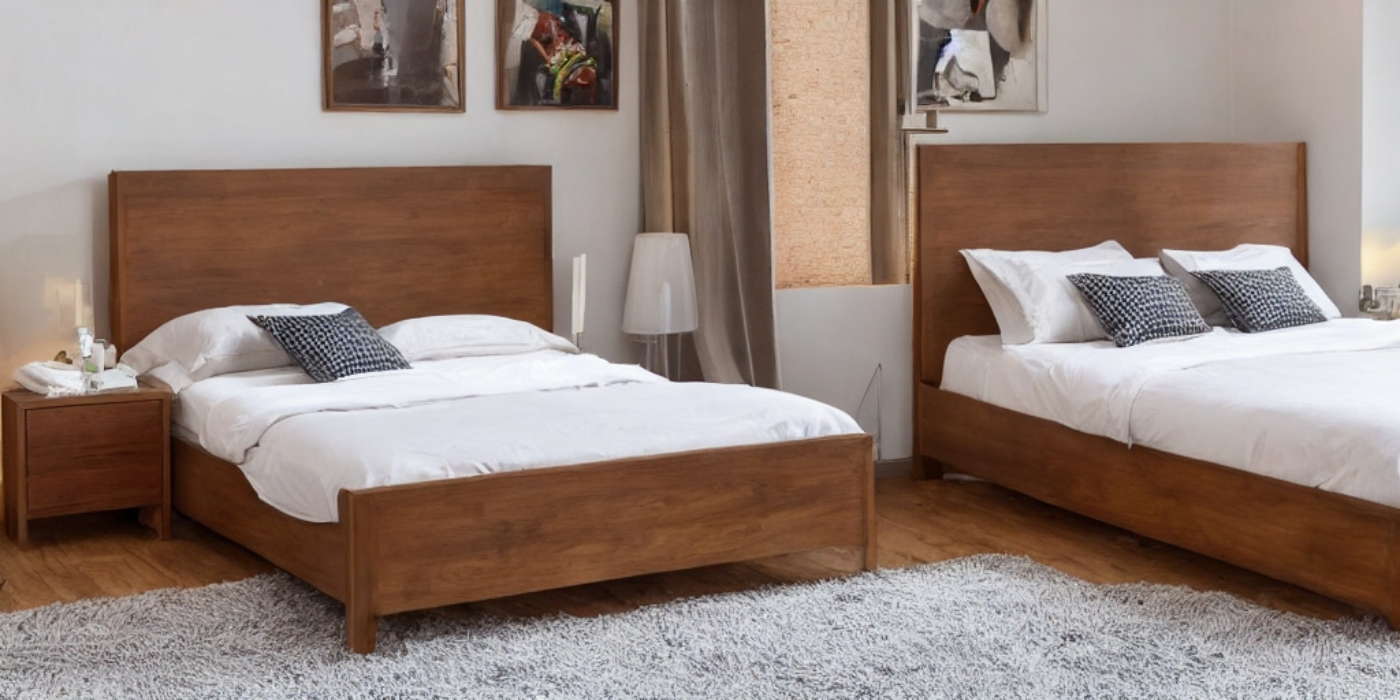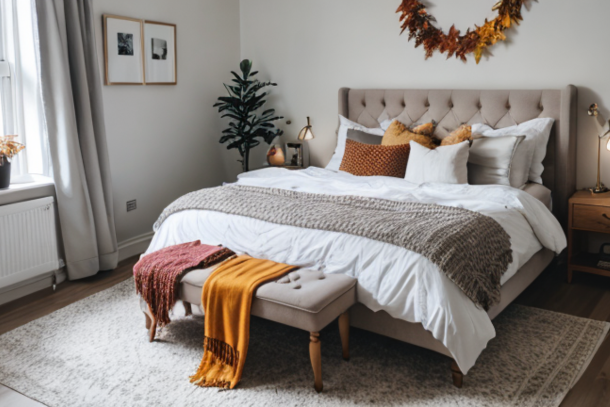What is a double bed size, how big is a double bed? History of the bed

The standard dimensions of a double bed are 54 inches wide and 75 inches long, or 137 cm wide and 191 cm long.
A "double bed" is also commonly referred to as a "full bed" in the United States.
Do note that these dimensions can slightly vary depending on the country and manufacturer. The double bed is designed to comfortably accommodate one adult with plenty of space, or two adults in closer quarters. It's larger than a twin bed but smaller than a queen or king bed.
The sizes between the US and Europe do vary with continental European being larger in some cases
| Name | Size in Inches (US) | Size in Centimeters (US) | Area in Square Inches (US) | Area in Square Centimeters (US) | Size in Inches (EU) | Size in Centimeters (EU) | Area in Square Inches (EU) | Area in Square Centimeters (EU) |
|---|---|---|---|---|---|---|---|---|
| Single | 39" x 75" | 99 cm x 191 cm | 2925 sq in | 18909 sq cm | 35" x 79" | 90 cm x 200 cm | 2765 sq in | 18000 sq cm |
| Twin | 39" x 75" | 99 cm x 191 cm | 2925 sq in | 18909 sq cm | N/A | N/A | N/A | N/A |
| Twin XL | 39" x 80" | 99 cm x 203 cm | 3120 sq in | 20157 sq cm | N/A | N/A | N/A | N/A |
| Double | 54" x 75" | 137 cm x 191 cm | 4050 sq in | 26133 sq cm | 55" x 79" | 140 cm x 200 cm | 4345 sq in | 28000 sq cm |
| Full | 54" x 75" | 137 cm x 191 cm | 4050 sq in | 26133 sq cm | N/A | N/A | N/A | N/A |
| Queen | 60" x 80" | 152 cm x 203 cm | 4800 sq in | 30976 sq cm | 63" x 79" | 160 cm x 200 cm | 4977 sq in | 32000 sq cm |
| King | 76" x 80" | 193 cm x 203 cm | 6080 sq in | 39274 sq cm | 71" x 79" | 180 cm x 200 cm | 5619 sq in | 36000 sq cm |
| California King | 72" x 84" | 183 cm x 213 cm | 6048 sq in | 39078 sq cm | N/A | N/A | N/A | N/A |
| Super King | N/A | N/A | N/A | N/A | 79" x 79" | 200 cm x 200 cm | 6241 sq in | 40000 sq cm |
It is important to note that bed sizes can vary depending on the manufacturer. Always check the dimensions of a bed before you buy it to make sure it is the right size for your needs.
Bed manufacturers
Here are several bed manufacturers known for their quality and reputation:
- Tempur-Pedic: Known for their memory foam mattresses, they offer a variety of models to suit different needs.
- Sealy: This manufacturer provides a wide range of mattresses, from innerspring to memory foam and hybrid models.
- Simmons (Beautyrest): Simmons is a well-known brand offering luxury mattresses under the Beautyrest line.
- Serta: They offer a wide variety of mattresses, including their popular iComfort series.
- Casper: An online mattress retailer that has gained popularity for its delivery method – the bed-in-a-box.
- Purple: Known for their unique "Purple Grid" layer aimed at offering both support and pressure relief.
- Tuft & Needle: This online mattress company is known for their affordable, high-quality foam mattresses.
- IKEA: A budget-friendly option offering a variety of mattresses and bed frames.
- Sleep Number: Famous for their adjustable firmness beds that allow customization on each side of the bed.
- Stearns & Foster: This luxury brand offers innerspring and hybrid mattresses.
- Leesa: An online mattress retailer known for their high-quality foam and hybrid mattresses.
- Saatva: This company sells luxury mattresses online, including innerspring, memory foam, and hybrid models.
The Bed: A Place to Sleep, Rest, Relax and Recharge
The history of the bed is a long and varied one. The earliest known beds were made from natural materials, such as leaves, grass, and animal skins. These beds were often simple and uncomfortable, but they provided a place to sleep and rest.
The Egyptian Mattress: The First of Its Kind and the Start of Good Sleep Hygiene
The Egyptians were the first to create what we would consider a mattress. They made them from a variety of materials, including straw, feathers, and animal skins. The mattresses were often stuffed with herbs and spices to make them smell good and to help keep bugs away.
The Egyptians also developed the first bed frames. These frames were often made from wood and decorated with gold and silver. The beds were often very elaborate and were a status symbol.
The Egyptians believed that sleep was important for both physical and spiritual health. They often slept on their sides with their knees bent. They also believed that dreams were messages from the gods and that they could be interpreted to predict the future.
The Egyptians' use of mattresses and bed frames had a major impact on the development of sleep hygiene. Their beds were more comfortable and supportive than anything that had come before, and their belief in the importance of sleep helped to promote good sleep habits.
Roman Marble and Stone Beds: A Symbol of Luxury and Status
Roman marble and stone beds were luxury items in ancient Rome. They were made from the finest marble, granite, and limestone and were often decorated with intricate carvings sometimes decorated with gold or silver. These beds were often very large and could accommodate multiple people.
Marble and stone beds were a status symbol in ancient Rome. They were only owned by the wealthy and powerful, and they were a way to show off one's wealth and status. These beds were seen as a sign of luxury and comfort.
The use of marble and stone beds declined in the late Roman Empire, due to a number of factors, including the rise of Christianity and the decline of the Roman economy. However, these beds continued to be used by the wealthy and powerful in the Byzantine Empire and in the Islamic world.
The Thalamos: The Private Room for Sleeping and Bathing
The most common type of bed in ancient Greece was the kline, which was a couch or bed that was used for both sleeping and reclining. Klines were typically made of wood and had a soft mattress. They were often decorated with carvings or paintings.
Another type of bed in ancient Greece was the thalamós, which was a more elaborate bed that was used for sleeping only. Thalamós were typically made of wood and had soft mattresses and pillows. They were also decorated with carvings or paintings.
The thalamos was a private room that was used for sleeping and bathing. The thalamos was typically located on the upper floor of the house and had a view of the surrounding area.
Beds in ancient Greece were an important part of daily life. They were used for sleeping, reclining, and bathing. The type of bed that a person had was often a status symbol, with the wealthy having more elaborate beds than the poor.
The Bedchamber: The Private Room for Sleeping and Bathing
Beds in the Middle Ages were often simple and unadorned, but some were quite elaborate.
The most common type of bed in the Middle Ages was the four-poster bed. Four posts supported a canopy that kept out insects and drafts. The mattress was typically made of straw or feathers, and the bed was often covered with a bedspread or quilt.
Another type of bed in the Middle Ages was the daybed. Daybeds were typically used for lounging or sleeping during the day. They were often made of wood and had a soft mattress.
Beds in the Middle Ages were often placed in the bedchamber, which was a private room that was used for sleeping and bathing. The bedchamber was typically located on the upper floor of the house.
Beds in the Renaissance: A Time of Elegance and Sophistication
Beds in the Renaissance were a reflection of the changing social and cultural values of the time. They became more elaborate and ornate and were often used as a way to display wealth and status.
One of the most popular types of beds in the Renaissance, the four-poster bed had a canopy that was often decorated with tapestries or other textiles, and it served to keep out insects and drafts.
Another popular type of bed in the Renaissance was the tester bed. It was similar to the four-poster bed, but it had a tester, which was a frame that was suspended from the ceiling and supported the canopy. Tester beds were often very elaborate, and they were often used by royalty and other wealthy individuals.
The Renaissance also saw the development of new types of bedding, such as bedspreads and quilts. These items were often made of silk or other luxurious fabrics, and they added a touch of elegance to the bedroom.
The Renaissance was a time of great change and upheaval, but it was also a time of great beauty and sophistication. Beds were no exception, and they reflected the changing values and tastes of the time.
Beds in 19th Century Literature, Art, and Music
Beds in the 19th century underwent a number of changes, reflecting the changing social and cultural values of the time. They became more comfortable, more private, and more individualized.
One of the most significant changes in 19th century beds was the introduction of metal bedsprings. Metal bedsprings provided better support and comfort than traditional rope or woollen bedframes, and they also made beds easier to assemble and disassemble. This made them more affordable and accessible to a wider range of people.
The 19th century also saw the development of new types of bedding, such as mattresses and pillows filled with horsehair or down. These materials provided better support and comfort than traditional straw or feather mattresses, and they also made beds more hygienic.
Finally, the 19th century saw the increasing importance of privacy in the bedroom. Beds were no longer seen as simply a place to sleep, but also as a place to relax and unwind. This led to the development of more private bedrooms, with doors that could be closed to keep out unwanted guests.
Beds in the 20th Century: A Century of Change
One of the most significant changes in 20th century beds was the introduction of new materials and technologies. In the early 20th century, innerspring mattresses became popular, providing better support and comfort than traditional mattresses. In the mid-20th century, memory foam mattresses were invented, providing even more support and comfort. And in the late 20th century, latex mattresses were introduced, offering a combination of support and comfort.
Another important change in 20th century beds was the increasing popularity of platform beds. Platform beds are raised off the ground, providing a more comfortable sleeping surface and making it easier to clean underneath the bed. They also became more popular in the 20th century because they are often more space-efficient than traditional beds.
Development of new types of bedding, such as duvets and down comforters hit the market. These materials provided better warmth and comfort than traditional blankets, and they also made beds more stylish along with the addition of features such as headboards, footboards, and built-in storage.
How to Choose the Right Bed Materials for You
Today, beds are made from a variety of materials, including wood, metal, fabric, and foam. The type of material used for a bed will depend on a number of factors, including the style of the bed, the budget, and the individual's preferences.
Some of the most common materials used for beds today include:
- Wood: Wood is a popular material for bed frames because it is strong, durable, and can be finished in a variety of styles. Some of the most popular types of wood used for bed frames include oak, maple, and cherry.
- Metal: Metal is another popular material for bed frames because it is strong and durable. Metal bed frames are often finished in a variety of colours, including black, white, and silver.
- Fabric: Fabric is a popular material for bed frames because it is soft and comfortable. Some of the most popular types of fabric used for bed frames include cotton, linen, and velvet.
- Foam: Foam is a popular material for mattresses because it is soft, comfortable, and supportive. Some of the most common types of foam used for mattresses include memory foam, latex foam, and polyurethane foam.
In addition to the materials used for the bed frame and mattress, there are a number of other materials that are used in the construction of beds, including:
- Bed slats: Bed slats are horizontal pieces of wood or metal that support the mattress. Bed slats are typically made of wood or metal, and they are often spaced about 2 to 3 inches apart.
- Box spring: A box spring is a platform that is placed under a mattress. Box springs are typically made of wood or metal, and they are often covered with a fabric or foam cover.
- Mattress topper: A mattress topper is a layer of material that is placed on top of a mattress. Mattress toppers are typically made of foam, memory foam, or latex, and they can be used to add comfort and support to a mattress.
- Bedding: Bedding is the material that is used to cover a bed, including sheets, pillowcases, blankets, and comforters. Bedding is typically made of cotton, linen, or wool, and it can be found in a variety of colours and patterns.
The materials used for beds can vary depending on the style of the bed, the budget, and the individual's preferences. There are a number of factors to consider when choosing materials for a bed, including comfort, durability, and style.
Putting the topic of beds to sleep
Beds have come a long way since their early beginnings. From simple platforms made of leaves and grass to elaborate four-poster beds, beds have evolved to reflect the changing needs and desires of society. Today, beds are available in a wide variety of styles, sizes, and materials to suit every taste and budget.
One of the most significant changes in bed design has been the introduction of new materials and technologies. In the early 20th century, innerspring mattresses became popular, providing better support and comfort than traditional mattresses. In the mid-20th century, memory foam mattresses were invented, providing even more support and comfort. And in the late 20th century, latex mattresses were introduced, offering a combination of support and comfort.
Another important change in bed design has been the increasing popularity of platform beds. Platform beds are raised off the ground, providing a more comfortable sleeping surface and making it easier to clean underneath the bed. They are also often more space-efficient than traditional beds.
Today, beds are more than just a place to sleep. They are also a way to express our personal style and taste. With so many options available, there is sure to be a bed that is perfect for everyone.
Related to this article are the following:
I do hope you have enjoyed this article and hope that you will subscribe to my newsletter so you can get the latest information about all things naturally relaxing.
Stay in touch, join the Naturally Relaxing Newsletter
Newsletter Signup
Post Your Comments
or post as a guest
Be the first to comment.
Latest articles in Sleep

The Power of Waterfall Sounds for Enhanced Sleep Quality

Embracing Autumn: Sleep Routines for the British Season

Autumnal Slumber: Understanding Our Seasonal Sleep Patterns

Crafting the Ideal Autumnal Sleep Sanctuary

Savouring Autumn: Foods to Enhance Your Sleep






